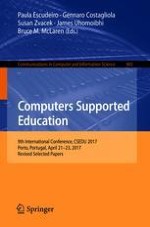2018 | Book
Computers Supported Education
9th International Conference, CSEDU 2017, Porto, Portugal, April 21-23, 2017, Revised Selected Papers
Editors: Paula Escudeiro, Gennaro Costagliola, Susan Zvacek, James Uhomoibhi, Bruce M. McLaren
Publisher: Springer International Publishing
Book Series : Communications in Computer and Information Science
